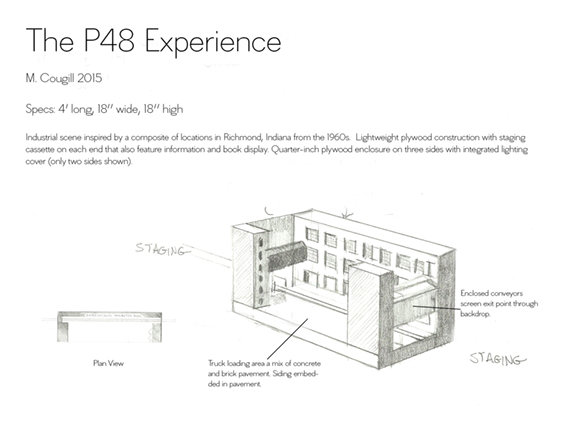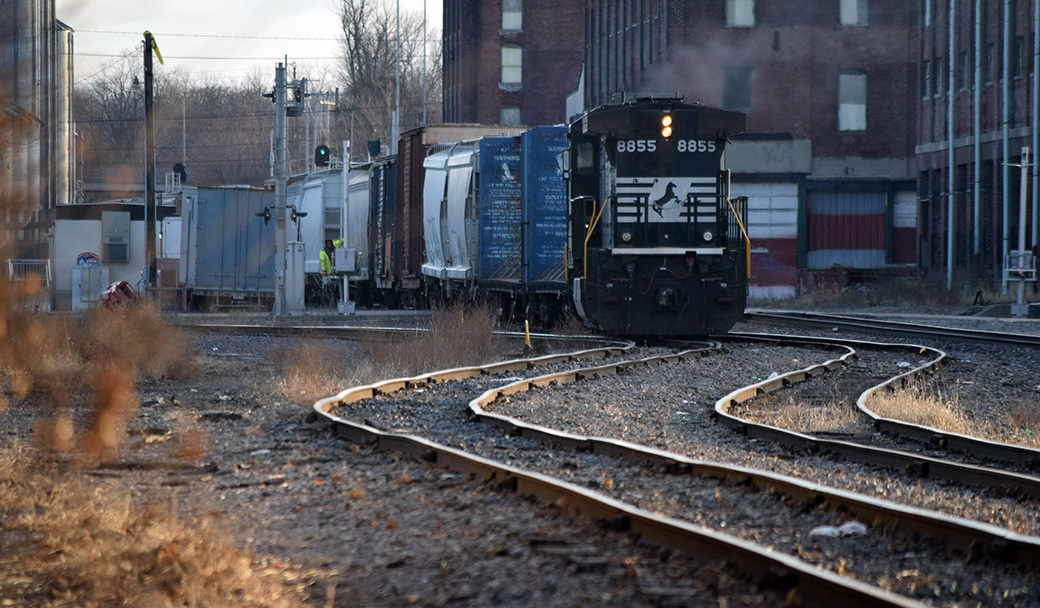In September of 2015 I wrote about the first iteration of a display layout I called the P48 Experience. The core scene consisted of a full-scale length warehouse on a four-foot long module. Unfortunately, the overall design was poorly conceived from the start due to my inexperience with the form. I intended the module to be shallow in depth but it grew into something deeper and construction as a whole was clumsy. So I abandoned that effort, though I still felt the idea was worth pursuing and decided to let it simmer a bit more.

In August of 2016, I dismantled my so-called permanent layout because I felt it was more than I needed. I wanted to greatly simplify my involvement and kept returning to the question of how much do I need? How much operation, how much of a view, how much depth and height, passing every aspect through this filter. I also decided to ignore everything I know about “model railroading” because that paradigm is getting in my way.
If you feel stuck with a design, one solution is to throw caution to the wind and do something crazy. In this case “crazy” is using quarter-inch scale in an ultra minimum space. The scale has a stigma around the perceived amount of space it requires. A stigma based on modeling mainline action in the traditional manner. However, when I look at the scale, I see an incredible potential for close-up immersive modeling.
Smooth operation and precise car handling interest me more than mindless running. Quarter-inch scale models have a sense of mass that we should exploit to the fullest. This quality, combined with a proper setting, immerses you in the railroad narrative in a way the smaller scales can never duplicate. Yet, people continue to treat the scale like HO and, in the process, lose something significant. My intent is to zero in on how cars are handled, along with the interaction between the crewman on the ground and the locomotive.

From our unrealistic helicopter viewpoint, we seldom think of this relationship. We not only see both ends of the train at once but also into the next town, over the mountain and beyond. This skews our approach, especially when we’re playing engineer and brakeman simultaneously. Since we can see how far to shove and whether the points are aligned, we just manipulate the throttle accordingly. Yes, it’s an intuitive way to run but could there be other alternatives? Watching numerous videos of switching and my own first hand observation paints a very different picture. The engine doesn’t move until the brakeman indicates it’s safe to do so. The ground man also informs the engine about distance and when to brake before coupling. Maybe it’s just me, but this is a stark contrast to typical model railroad operations.
While my goal is simplicity, I’m looking far beyond the track plan to the entire presentation. This includes the overall design, the lighting, how the display fits in the room, even my workbench and storage needs. We tend to think of these as separate concerns that are only addressed after the track plan is established.
If I can see what I’m doing, there’s enough light.
I’ll worry about the fascia later.
The workbench and stuff can go in that leftover corner over there.
It’s my view however that all of these aspects are interrelated pieces of a larger whole and when considered as a whole, make for a more cohesive experience of what the craft can offer. Handled with care and restraint, the small space that everyone dreads can become like the close friend that brings out the best in you. Such constraints sharpen one’s focus because there simply isn’t room for non-essentials. Every item has to contribute to the story being told or it’s gone.
This is about challenging my assumptions. It’s about bringing several of my interests together and looking at things with a fresh eye. It’s about deepening my connection with railroading in a way that is meaningful and satisfying.
Regards,
Mike
“Maybe it’s just me…”
It’s not; I think and feel the same way about scaled down railroad operations these days.
“I see an incredible potential for close-up immersive modeling.”
Right on! I like to say that since I’ve scaled down the desired prototype representation — Frisco’s Fairgrounds Branch (https://kcspur.blogspot.com) — is only 5283 feet from beginning to end, it seems natural to scale up the models and orient myself closer to the ground as if I’m the railfan or the conductor on the ground.
“…it seems natural to scale up the models and orient myself closer to the ground as if I’m the railfan or the conductor…”
Exactly Rich.
Regards,
Mike